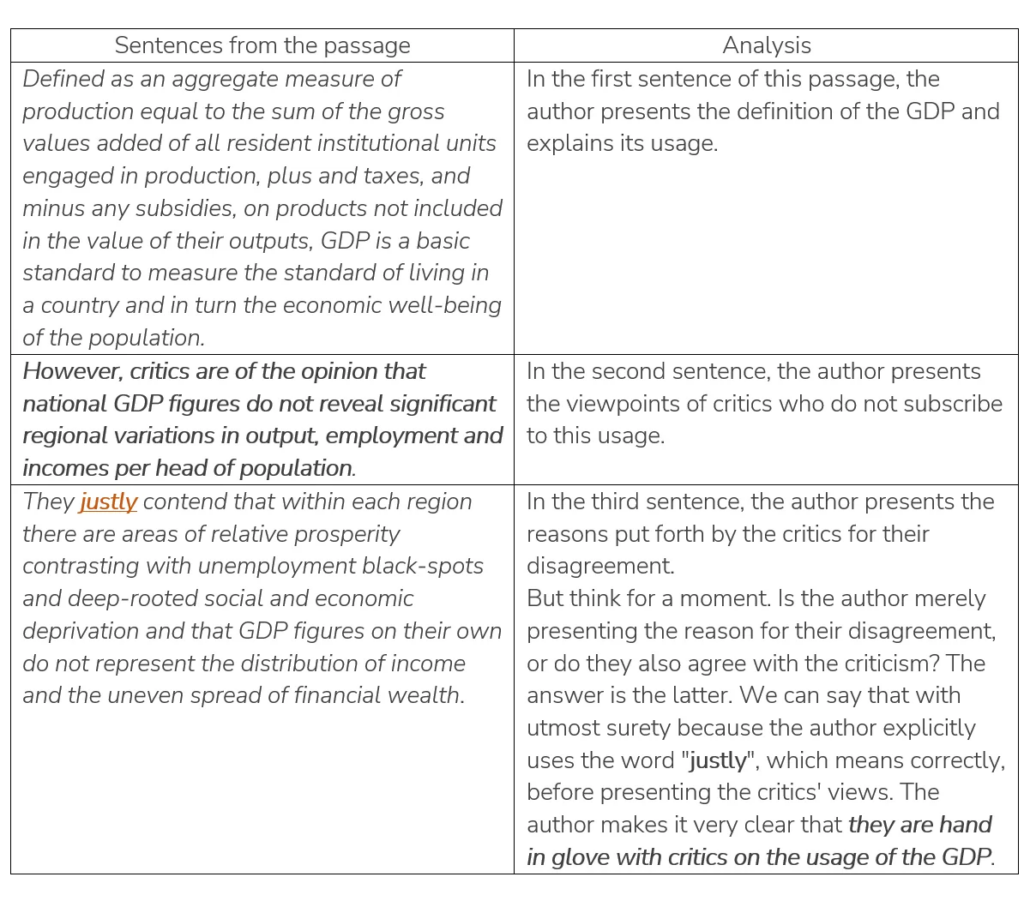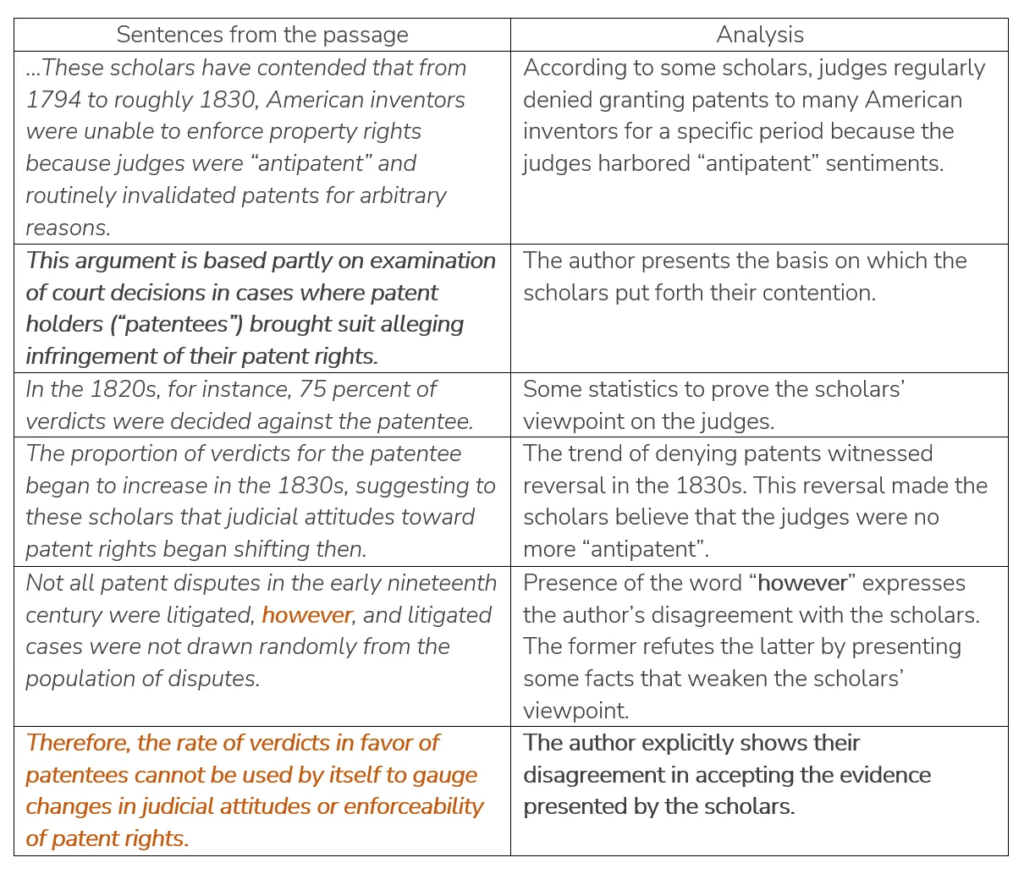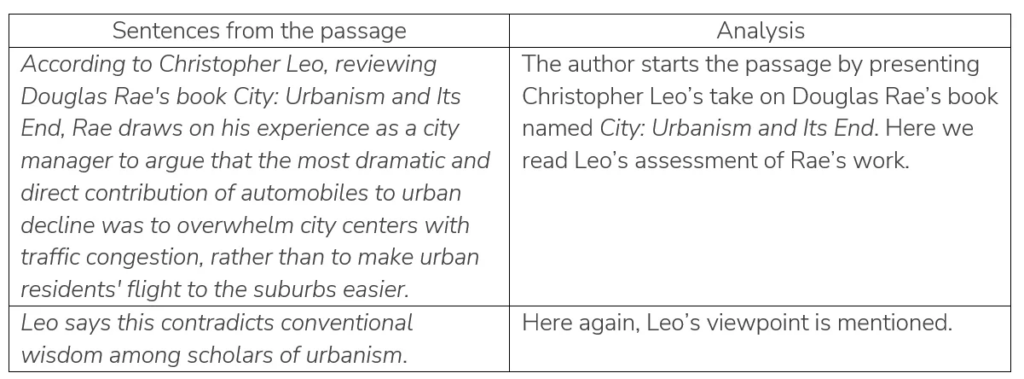Introduction
Many times, in a Reading Comprehension passage, the author may present the viewpoints of other personalities on the topic of discussion. These personalities may hold their views against or for the topic. As a test taker, we must know whether the author agrees with, disagrees with, or remains neutral to the viewpoints of these personalities. “But how do we know the author’s stance?” you may wonder. The answer is simple. The author provides the answer in the passage itself. We must be alert when picking up those cues. Through this article, we will study official passages to determine whether the author possesses the same feather to flock with them or has different strokes to refute them.
1. Author as part of the flock
A. Official Passage Analysis
The following is the first paragraph of an official passage.
Defined as an aggregate measure of production equal to the sum of the gross values added of all resident institutional units engaged in production, plus and taxes, and minus any subsidies, on products not included in the value of their outputs, GDP is a basic standard to measure the standard of living in a country and in turn the economic well-being of the population. However, critics are of the opinion that national GDP figures do not reveal significant regional variations in output, employment and incomes per head of population*. They* justly contend that within each region there are areas of relative prosperity contrasting with unemployment black-spots and deep-rooted social and economic deprivation and that GDP figures on their own do not represent the distribution of income and the uneven spread of financial wealth.

The author starts the second paragraph of the same passage as follows: The idea that rising national prosperity can still be accompanied by rising relative poverty is rightly at the heart of the criticism meted out for using GDP as a measure of the general well-being of the population of a region. The presence of the highlighted word once again proves that the author holds the same viewpoint on the use of the GDP as the critics.
B. Words/Phrases Indicating Author’s agreement
Since the onus is on the author to help readers know that the author agrees with the viewpoints of some other entities in the passage, the author may use such affirmative expressions as justly, rightly, correctly, legitimately, indeed, undoubtedly, certainly, without question, understandably, etc. Please note that this is not an exhaustive list. The affirmation from the author may appear in various other phrases and sentences as well.
2. Author in refutation of the viewpoints of other personalities
A. Official Passage Analysis
Let’s study the following official passage now:
…These scholars have contended that from 1794 to roughly 1830, American inventors were unable to enforce property rights because judges were “antipatent” and routinely invalidated patents for arbitrary reasons. This argument is based partly on examination of court decisions in cases where patent holders (“patentees”) brought suit alleging infringement of their patent rights. In the 1820s, for instance, 75 percent of verdicts were decided against the patentee. The proportion of verdicts for the patentee began to increase in the 1830s, suggesting to these scholars that judicial attitudes toward patent rights began shifting then.
Not all patent disputes in the early nineteenth century were litigated, however*, and litigated cases were not drawn randomly from the population of disputes.* Therefore the rate of verdicts in favor of patentees cannot be used by itself to gauge changes in judicial attitudes or enforceability of patent rights.

B. Words/Phrases Indicating Author’s Refutation or Disagreement
The author may use such expressions as however, nevertheless, nonetheless, on the contrary, conversely, in contrast, mistakenly, erroneously, fallaciously, etc., to present their disagreement with the viewpoints of other entities mentioned in the passage. Please note that this is not an exhaustive list. The refutation can be expressed through many other phrases and sentences.
3. Author remains neutral
It is not necessary for the author to either agree or disagree with the viewpoints of other personalities mentioned in the passage. The author may choose to remain neutral and not present at all their own opinion on such viewpoints. In such cases, the viewpoints of other entities are stated as factual statements.
A. Official Passage Analysis
Let’s study the first paragraph of this official passage:
According to Christopher Leo, reviewing Douglas Rae’s book City: Urbanism and Its End, Rae draws on his experience as a city manager to argue that the most dramatic and direct contribution of automobiles to urban decline was to overwhelm city centers with traffic congestion, rather than to make urban residents’ flight to the suburbs easier. Leo says this contradicts conventional wisdom among scholars of urbanism.

So, we do not hear anything from the author personally about Leos’s views on Rae’s work. The second paragraph of this passage also contains only Leo’s criticism of Rae’s “biased” considerations in writing this book. Absolutely nowhere in the passage does the author either take the side of any of these two personalities or go against them.
4. Author makes their stance clear
So, whenever the author presents the viewpoints of some other personalities in an RC passage, all we need to do is read through the passage carefully to pick up those apparent clues that the author incorporates to make his stance very clear whether they agree or disagree with those personalities as we saw in the two official passages above.
- If the author agrees with the viewpoints of the other people, they will EXPLICTLY use affirmative expressions to show their agreement.
- If they do not, then that will also be CLEARLY indicated in the passage through the expressions used by the author.
- The absence of positive and negative expressions sugggests that the author is neutral to the viewpoints of the other people mentioned in the passage.
Takeaway
In the world of the GMAT RC, the author of the passage is our best friend because we deal with a passage that they have written. So, the words and phrases they use become our guide that helps us navigate the passage. In this article, we learned how to determine if the author agrees with, disagrees with, or remains neutral to the viewpoints of other personalities mentioned in the passage. But why is it so important to know this? If this is the question that is arising in your mind, then stay tuned. Soon, we will present the answer to this critical question.
Till then, Happy Learning!
And try your hand at these exercise questions to solidify your understanding.
Exercise Questions
Analyze passages to determine the author’s stance (agree, disagree, or neutral) on viewpoints of mentioned entities. Also, identify these entities.
To submit your answers, create three headings*: Agrees, Disagrees, Neutral and write the passage number against them. Next to the passage number, please mention the entity the author agrees or disagrees with.*
Here is an example: (Note that the examples may or may not be correct)
- Agrees: In 1 with the long-held theory; In 2 with Professor Smith’s theory
- Disagrees:…
- Neutral: …
Passages
1. The theory that dinosaurs were cold-blooded has long been accepted. Nevertheless, recent evidence suggests this view is mistaken, as it fails to account for the high growth rates observed in dinosaur fossils.
2. Many historians have debated the causes of the Industrial Revolution. Professor Smith’s theory, which emphasizes the role of technological innovation, is undoubtedly the most convincing explanation to date.
3. It has been proposed by some economists that cryptocurrency could eventually replace traditional currencies. Proponents argue that it offers more security and transparency.
4. In the debate over climate change policy, one perspective is that market-based solutions are most effective. Advocates of this approach contend that carbon pricing would drive innovation in clean technologies.
5. The new healthcare policy has faced significant opposition. However, proponents of the policy justly emphasize its potential to reduce costs and improve access for millions of citizens.
6. Proponents of the new urban development plan claim it will revitalize the city center. This argument, however, ignores the potential displacement of long-time residents and local businesses.
7. According to recent studies, coffee consumption may have health benefits. Some researchers suggest that moderate coffee intake could reduce the risk of certain diseases.
8. Critics argue that the current economic model is unsustainable. They rightly point out that infinite growth is impossible in a world of finite resources.
9. Some economists argue that increasing the minimum wage will lead to job losses. However, this view overlooks the potential boost to consumer spending and overall economic growth that could result from higher wages.














